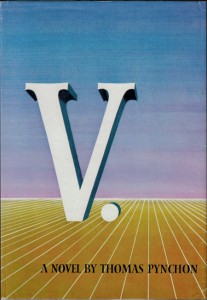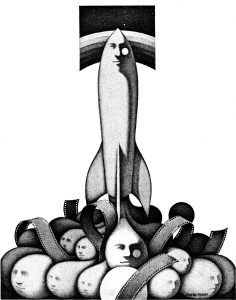Cook’s Tour
The New York Review of Books, June 1, 1963
by Thomas Pynchon
Lippincott, $5.95
 Nothing more intricately conceived than Thomas Pynchon’s first novel has appeared in American fiction since the work in the thirties by Faulkner, Nathaniel West and Djuna Barnes, the last two being among the writers who have given him the courage of his artifices and of the assumptions that go with them. V. is full of self-mystified people consistently avoiding direct relations with one another through disguise or evasion, people living the disrupted existences either of the Cook’s Tour, in one plot or in the other, of a kind of contemporary tourism called “yo-yoing,” the pointless repetitive passage and return on any convenient ferry or subway. Neither of the two interwoven plots is presented in sequence. One involves a self-styled schlemihl named Benny Profane, his naval buddies, and a gang in New (sometimes “Nueva”) York who call themselves the Whole Sick Crew. The other is an international melodrama of spying that covers the years since 1898. It is reconstructed by Herbert Stencil – the name meaning that he is a copy of his father in the effort to keep track of the elusive V. He cannot be sure what V. is, whether she (or it) is not wholly a fantasy.
Nothing more intricately conceived than Thomas Pynchon’s first novel has appeared in American fiction since the work in the thirties by Faulkner, Nathaniel West and Djuna Barnes, the last two being among the writers who have given him the courage of his artifices and of the assumptions that go with them. V. is full of self-mystified people consistently avoiding direct relations with one another through disguise or evasion, people living the disrupted existences either of the Cook’s Tour, in one plot or in the other, of a kind of contemporary tourism called “yo-yoing,” the pointless repetitive passage and return on any convenient ferry or subway. Neither of the two interwoven plots is presented in sequence. One involves a self-styled schlemihl named Benny Profane, his naval buddies, and a gang in New (sometimes “Nueva”) York who call themselves the Whole Sick Crew. The other is an international melodrama of spying that covers the years since 1898. It is reconstructed by Herbert Stencil – the name meaning that he is a copy of his father in the effort to keep track of the elusive V. He cannot be sure what V. is, whether she (or it) is not wholly a fantasy.
Even the title of the novel is thus cryptographic, V. comes to stand for anything to which, in the absence of love, one devotes his passion and curiosity. It can refer to a bar called V-note, where Benny and the Crew listen to a jazz player named McClintic Sphere; to Valetta on Malta; to a sewer rat, Veronica, so named by a Father Fairing who wants, in his efforts to convert the rats of New York to Roman Catholicism, to make Veronica his first saint and his mistress; to Venus, the goddess, the planet, the mons Veneris – to Venezuela and Queen Victoria, to Vesuvius and other volcanoes, to the mythical land of Vheissu with its iridescent spider monkeys. So far as Stencil is concerned, however, V. is a lady internationally renowned as spy, lover, transvestite and impersonator. She has been on the scene of various international crises since her first appearance in Cairo during the Fashoda incident in 1898. There, in her nineteenth year, and under the name Virginia Wren, she is deflowered by a British agent. The next year she is in Florence coincident with a manufactured crisis over Vheissu (and, of course, Venezuela), during which she seduces Stencil’s father at the British consulate, thereby becoming Stencil’s mother. In subsequent impersonations, she is identified in Paris in 1913 as the Lesbian fetishist lover of a dancer named Melanie l’Heuremaudit. Still later, she is placed in German Southwest Africa during a native rebellion in 1922, and in this instance is given two simultaneous identities by Stencil: as a child of sixteen with white-blond, hip-length hair and the information that “I am Hedwig Vogelsang, and my purpose on earth is to tantalize and send raving the race of man”; and as the older, more subtle Vera Meroving who sports a glass eye, the face of which is also a watch, and a star sapphire sewn into her navel on Malta in 1919 – she was known then as Veronica Manganese. She makes her last appearance, in Stencil’s increasingly weird dehumanization of the figure, again on Malta in 1939 when, disguised as a priest with a detachable gold foot, she is knocked unconscious in a bombing raid and disassembled by a group of children who are less mean than inquisitive.
[Read more…]
